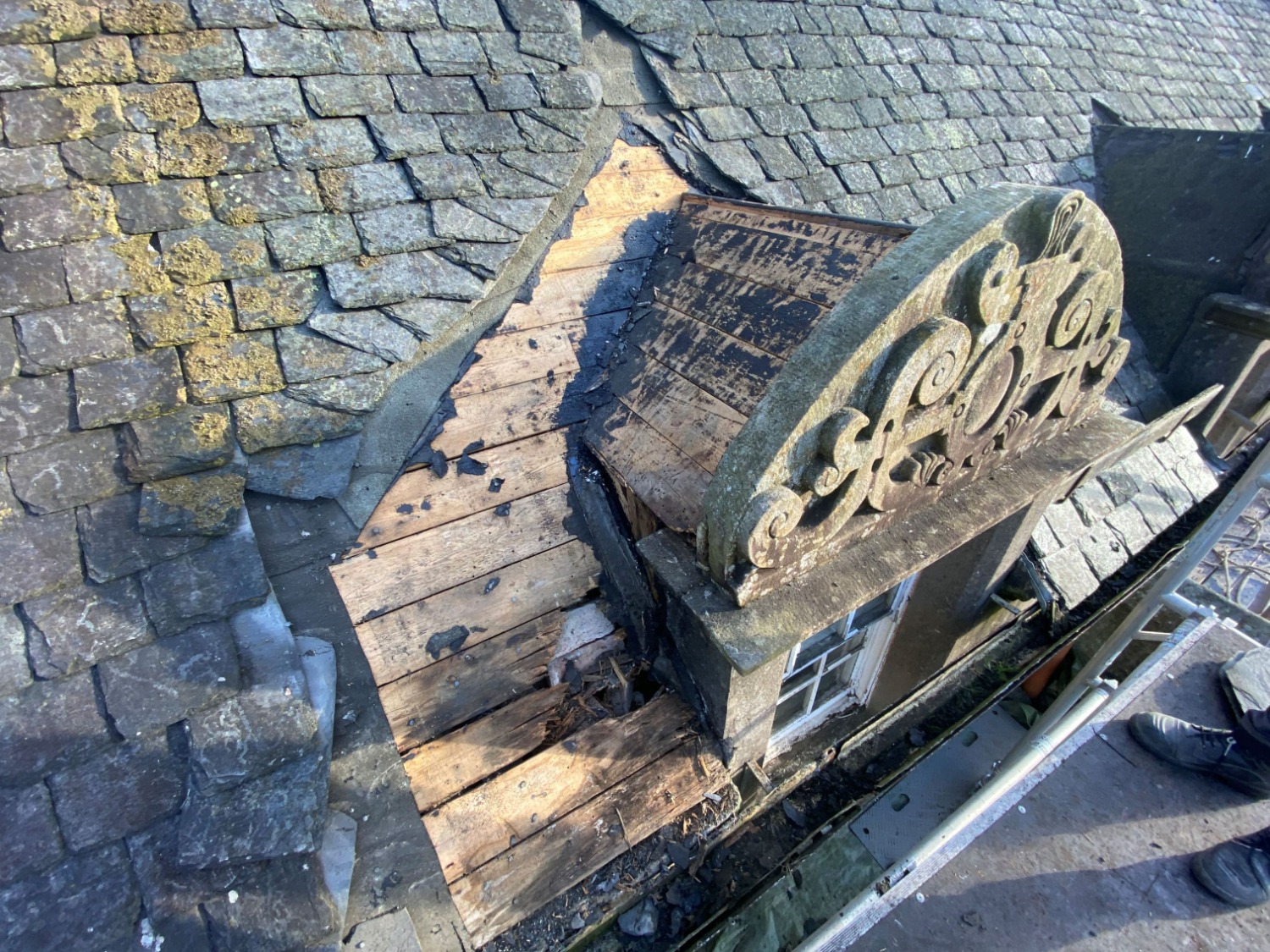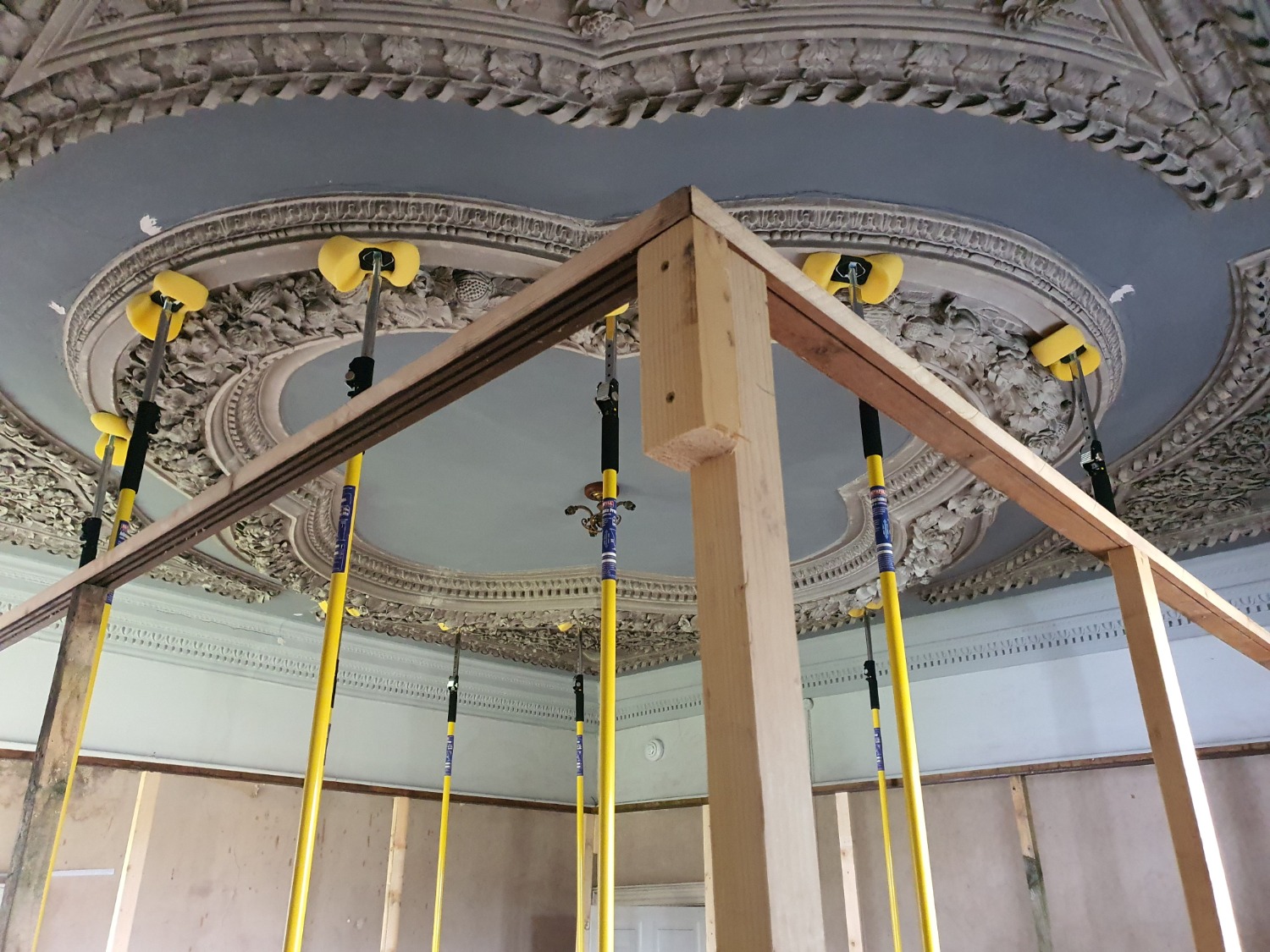
OLD Plean Roofing has been contracted to restore the roof of Stirling’s historic Bannockburn House as part of a long-term project to bring the 17th century building back to life.
The award-winning firm, founded by Mark and Fiona Thornton, will deliver the first phase of repairs and a team is on site daily conserving the deteriorating roof which is thought to be between 350 and 400-years-old.
Water ingress from the roof, which features hand-hewn wooden slate pegs and carvings on the beams, is putting the interior of the House and its ornate plasterwork ceilings at risk and the work is essential to preserve it for future generations.

Bannockburn House was completed around 1675 and features historically important architectural features including unique ceilings reputed to be the work of Houlbert and Dunsterfield – two highly skilled craftsmen who also created the ornate ceilings at Holyrood Palace.
The building has been home to many families across the centuries while its most famous inhabitant Bonnie Prince Charlie used it as a military headquarters for his Jacobite army in January 1746.
In 2017, Bannockburn House Trust took over ownership of the House, which had been uninhabited from the 1960s, following a community buyout. Since then, a team of volunteers has worked tirelessly to save the estate and breathe new life into it.
Catherine Bradley, head of research, conservation, and living history at Bannockburn House, is overseeing the roofing work which involves documenting and studying every piece of material which needs to be removed as part of the restoration project.
She said, “The major concern, which has caused many of the problems, is water ingress from the various roofs and this is the most time-consuming, resource-intensive and financially problematic issue the Trust faces in saving the House and surrounding buildings.
“The roofing works have begun addressing the problem – initially in areas affecting our ornate plasterwork ceilings and friezes – and are vital to save the historic fabric of the building. It’s a painstaking process and we are uncovering more and more about the history of the House as we go along which is quite fascinating.
“We’re working according to our conservation management plan and, starting with the roof dormers, each layer is being documented and studied and we’ll be conducting detailed analysis to learn more about the construction phases of the House.”
The restoration work includes regular consultations with a heritage expert and a bat ecologist is often on site to identify roosts and ensure bats living at the House remain undisturbed.
Old Plean Roofing, which is based at Stirling’s Manor Farm Business Park, was selected for the work due to the firm’s roofing expertise and local connections.
Dr Bradley added, “The House was built historically with local traders and the Trust felt it was important to continue that tradition and work with people familiar with the building materials and styles used. We also wanted to back the local economy and its tradespeople, to support the community as much as they have been supporting us and involve them in the heritage and history of the House.
“We needed a local company who would collaborate flexibly with us and be prepared to stop regularly to take photos and help with the documentation which is vital to preserving the House’s history. We sought someone who was happy to take the concerns of the building on board and who understood that if we find something of importance we have to wait to research it and gain permission to replace it. We also needed them to adhere to a conservation management plan and OPR contracts director Mark Thornton was more than happy to agree with all our specifications.”
The Old Plean Roofing team has undertaken some unusual tasks during the project including creating ‘bat slates’ with a gap for bats to get in and out of while the roof is being fixed.
They also uncovered sections of an old wooden table which had been used during previous repairs to roof dormers and which may indicate how materials were scarce at the time the work was carried out. The wood has been labelled and photographed and will be studied further by experts working to understand the history of the building.
Original roof sarking, slates and hand-hewn wooden pegs are also being examined as the project continues.
Mr Thornton said, “The restoration of Bannockburn House is one of the most interesting we’ve worked on and we’re pleased to be involved in a community project which is right on our doorstep. The restoration is going well and we’ve already carried out repairs to four rear dormer roofs which have stopped water coming into the main rooms.
“It’s been an unusual job involving tasks such as manufacturing bat slates which we’ve put in strategic places to give the bats somewhere to roost and direct them away from the areas being worked on. Bagging, tagging and photographing every single piece of slate and other material which needs to come off the roofs is also interesting and we’re enjoying the challenge and the opportunity to learn more about our local history as we go along.”
Further roofing work will include restoring the six Jacobean chimneys and the House is currently closed to the public with hopes it will be ready to reopen in the spring.
Project Scotland visited Old Plean Roofing’s Stirling base in 2022 to hear about the firm’s rapid growth. To read the article, click here.











